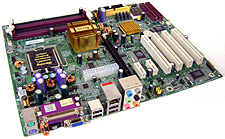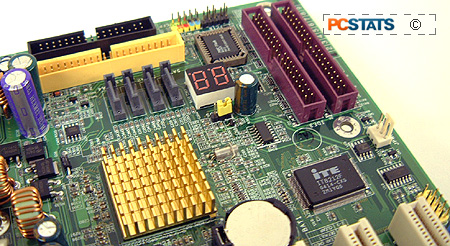After
some discussions for and against removing overclocking benchmarks entirely from
PCstats reviews, we have decided to change how we do things, but still include
them. From now on, PCstats reviews are simply listing the maximum overclocked
speed a motherboard is able to achieve here, rather than for each and every
benchmark.
Since overclocking can be a very subjective skill, it
just makes more sense to keep our benchmarks focused on the stock performance of
system components. Plus, by listing the maximum overclocked speeds of various
motherboards here, you have a better idea of which manufacturer really does
produce the best goods for enthusiasts!
The Epox
EP-5EGA+ overclocks higher than the two socket 775 Gigabyte motherboards, but is
far from the speeds attained by either Albatron board. Things could have been
better if Epox had included Northbridge voltage adjustments I think.
Epox Gets it Right.... Almost
 The "writing is on the wall" with
regards to PCI Express. If you're purchasing a new PC, or new components, you
should definitely go the PCI Express route. This way you won't be stranded with
an obsolete system in the future should you need to upgrade. Right?
The "writing is on the wall" with
regards to PCI Express. If you're purchasing a new PC, or new components, you
should definitely go the PCI Express route. This way you won't be stranded with
an obsolete system in the future should you need to upgrade. Right?
The Epox
EP-5EGA+ proved to be a good motherboard in most respects, but it is not
without a few quirks. Let's consider the positives first; it comes with
7.1-channel Intel 'High Definition Audio', IDE RAID, Gigabit ethernet, and
integrated Intel GMA900 graphics. In terms of expansion, the Epox 5EGA+ is
legacy friendly with four PCI slots, and future proof with two PCI Express x1
and a PCI Express x16 videocard slot. Personally, we're quite pleased with the
IDE RAID option because IDE drives will not be disappearing from stores anytime
soon.
 On the down side, the layout of the
board is mediocre at best. The Epox 5EGA+ is certainly not the best example Epox has
produced, and could benefit from a few refinements to make it much more
enthusiast friendly. The main issues relate to after market cooling solutions on
their PCI Express videocard, or the processor for that matter.
On the down side, the layout of the
board is mediocre at best. The Epox 5EGA+ is certainly not the best example Epox has
produced, and could benefit from a few refinements to make it much more
enthusiast friendly. The main issues relate to after market cooling solutions on
their PCI Express videocard, or the processor for that matter.
The close
proximity of the northbridge and main 24-pin ATX power connector to the rear of
the PCI Express x16 slot are limiting, as are the four large electrolytic
capacitors to the left of the CPU socket. Removing the videocard can be a pain
with those two small TEAPO capacitors in the way of the locking clip
too.
Don't get
me wrong though, not everything is poorly laid out on the Epox 5EGA+. The
grouping of IDE and SATA headers is neat and easy to access, and the board comes
with a nice little bundle of extras too. The benchmarks indicate that the
performance of the Epox EP-5EGA+ motherboard is quite good, but overclocking was
a bust. I would have anticipated better results from the EP-5EGA+ if it had some
Northbridge voltage adjustments... but hitting 220 MHz FSB is still not too shabby.
Bottom
line, if you're looking for an enthusiast grade motherboard for that special
Socket 775 Intel Pentium 4 processor, the Epox EP-5EGA+ offers good, but not
outstanding attributes. In fact, the EP-5EGA+ is probably best going to serve
you as a workstation board, where its Intel GMA900 video can be taken full
advantage of.
Find out
about this and many other reviews by joining the Weekly PCstats.com Newsletter
today!
Related Articles
Here are
a few other articles that you might enjoy as well...
1. Gigabyte GA-8ANXP-D Motherboard Review
2. Albatron Mars PX915G Pro Motherboard
Review
